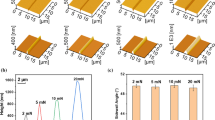Abstract
High-power semiconductor laser cavities are formed via the cleavage plane, and critically influence the reliability and performance of the laser. This paper investigates both the scratching operation and the cleavage operation to improve the quality of the cleavage plane during the entire cleavage process. The scratching capability index (SCI) variable was proposed to evaluate the scratch quality of GaAs. A series of scratching and cleavage experiments were carried out to investigate the effect of the scratch features on the GaAs cleavage plane. Experimental results of the scratching operation showed that a smaller scratching load and higher scratching speed were beneficial for reducing the kerf width and damage area width of GaAs. The cleavage operation on GaAs {100} cleavage planes exhibited crack propagation in the [1̄01̄] and [1̄00] directions and a slip direction in the <110> crystal direction. The calculated SCI variable correlated well with the scratch and cleavage qualities of GaAs, where a higher scratching SCI correlated with a smoother GaAs cleavage plane during cleavage processing. Thus, the SCI has the potential to relate the scratching parameters with the resulting cleavage plane quality of GaAs, which will help improve the manufacturing of semiconductor laser chips in the future.













Similar content being viewed by others
Referencess
Yuan QH, Jing HQ, Zhang QY, Zhong L, Liu SP, Ma XY (2019) Development and application of GaAs-based near-infrared high power semiconductor lasers. Laser Optoelectron Progress 56(4):35–48
Fomin E, Bondarev A, Slipchenko S, Rudova N, Pikhtin N (2019) Surface features of the AlN optical coating deposited on the facet of a high-power AlGaAs/GaAs semiconductor laser. J Phys 1400(5):055029
Jiang C, Wu T, Ye H, Cheng JY, Hao Y (2019) Estimation of energy and time savings in optical glass manufacturing when using ultrasonic vibration-assisted grinding. J Precis Eng Manufact-Green Technol 6(1):1–9
Ding ZS, Sun GX, Guo MX, Jiang XH, Li BZ et al (2020) Effect of phase transition on micro-grinding-induced residual stress. J Mater Process Technol 281:116647
Jiang C, Huang JL, Jiang ZY, Qian DB, Hong XL (2019) Estimation of energy savings when adopting ultrasonic vibration-assisted magnetic compound fluid polishing. J Precis Eng Manufact-Green Technol. https://doi.org/10.1007/s40684-019-00167-5
Park C, Kim H, Cho H, Lee T, Kim D, Lee S et al (2019) Effect of relative surface charge of colloidal silica and sapphire on removal rate in chemical mechanical polishing. J Precis Eng Manufact-Green Technol 6(2):339–347
Eunseok O, Lim S (2019) Removal of high-dose P+ ion-implanted photoresist on GaAs in the mixture of dimethyl sulfoxide and acetonitrile. J Ind Eng Chem 77:230–237
Wasmer K, Ballif C, Gassilloud R, Pouvreau C, Rabe R, Michler J et al (2005) Cleavage fracture of brittle semiconductors from the nanometer to the centimeter scale. Adv Eng Mater 7(5):309–317
Xu JY, Hu H, Zhuang CH, Ma GD, Han JL, Lei YL (2018) Controllable laser thermal cleavage of sapphire wafers. Opt Lasers Eng 102:26–33
Wasmer K, Ballif C, Pouvreau C, Schulz D, Michler J (2008) Dicing of gallium-arsenide high performance laser diodes for industrial applications Part I. Scratching operation. J Mater Process Technol 198(1–3):114–121
Wasmer K, Parlinska-Wojtan M, Graça S, Michler J (2013) Sequence of deformation and cracking behaviours of Galliume Arsenide during nano-scratching. Mater Chem Phys 138:38–48
Pouvreau C, Wasmer K, Hessler-Wyser H, Ganiere JD, Breguet JM, Michler J et al (2013) Nanoindentation cracking in gallium arsenide: Part II. TEM investigation. J Mater Res 28(20):2799–2809
Shen ZX, Chen RF, Dai LG, Zhu R, Zhang XL (2010) Effcts of temperatureon micro-hardness and crack initiation and expansion of single crystal gallium arsenide tested by indentation technique. J Chin Ceramic Soc 38(5):892–896
Sweet CA, Schulte KL, Simon JD, Steiner MA, Jain N, Young DL (2016) Controlled exfoliation of (100) GaAs-based devices by spalling fracture. Appl Phys Lett 108(1):011906
Liu W, Zhang SK, Stutzman M, Poelker M (2016) Effects of ion bombardment on bulk GaAs photocathodes with different surface-cleavage planes. Phys Rev Accelerat Beams 19(10):103402
Okui T, Hasegawa S, Fukutome H, Nakashima H (2000) Shearing orientation dependence of cleavage step structures on GaAs (110). Surf Sci 448(2000):219–224
Hess P (2014) Strength of semiconductors, metals, and ceramics evaluated by a microscopic cleavage model with Morse-type and Lennard-Jones-type interaction. J Appl Phys 116(5):053515
Wasmer K, Ballif C, Pouvreau C, Schulz D, Michler J (2008) Dicing of gallium-arsenide high performance laser diodes for industrial applications Part II. Cleavage operation. J Mater Process Technol 198(1–3):105–113
Liu QY, Zhou J, Bao JD, Zhao YW, Xiong LC, Shi TL et al (2019) A semi-empirical fracture model for silicon cleavage fracture and its molecular dynamics study. Theoret Appl Fract Mech 100:86–92
Fabijanic TA, Coric D, Musa MS, Sakoman M (2017) Vickers indentation fracture toughness of near-nano and nanostructured WC-Co cemented carbides. Metals 7(4):143
Sun TJ, Chen YF, Cheng JC, Chiu CL (2018) Optimizing the dicing saw parameters of 60 μm wafer dicing street. Microsyst Technol 24(10):3965–3971
Acknowledgements
This work was supported by National Natural Science Foundation of China (51475310).
Author information
Authors and Affiliations
Corresponding author
Ethics declarations
Conflict of interests
On behalf of all authors, the corresponding author states that there is no conflict of interest.
Additional information
Publisher's Note
Springer Nature remains neutral with regard to jurisdictional claims in published maps and institutional affiliations.
Rights and permissions
About this article
Cite this article
Gao, R., Jiang, C., Lang, X. et al. Experimental investigation of influence of scratch features on GaAs cleavage plane during cleavage processing using a scratching capability index. Int. J. of Precis. Eng. and Manuf.-Green Tech. 8, 761–770 (2021). https://doi.org/10.1007/s40684-020-00241-3
Received:
Revised:
Accepted:
Published:
Issue Date:
DOI: https://doi.org/10.1007/s40684-020-00241-3




